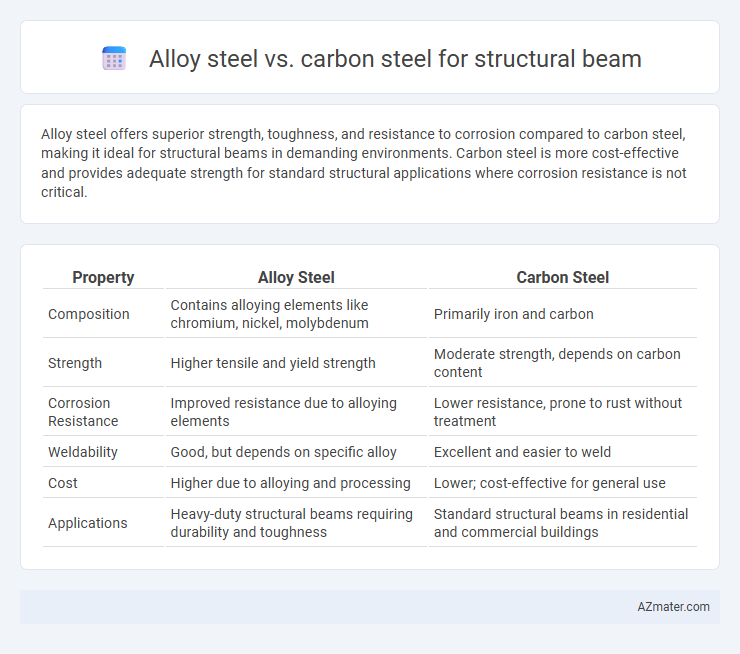Alloy steel offers superior strength, toughness, and resistance to corrosion compared to carbon steel, making it ideal for structural beams in demanding environments. Carbon steel is more cost-effective and provides adequate strength for standard structural applications where corrosion resistance is not critical.
Table of Comparison
| Property | Alloy Steel | Carbon Steel |
|---|---|---|
| Composition | Contains alloying elements like chromium, nickel, molybdenum | Primarily iron and carbon |
| Strength | Higher tensile and yield strength | Moderate strength, depends on carbon content |
| Corrosion Resistance | Improved resistance due to alloying elements | Lower resistance, prone to rust without treatment |
| Weldability | Good, but depends on specific alloy | Excellent and easier to weld |
| Cost | Higher due to alloying and processing | Lower; cost-effective for general use |
| Applications | Heavy-duty structural beams requiring durability and toughness | Standard structural beams in residential and commercial buildings |
Introduction to Alloy Steel and Carbon Steel
Alloy steel contains additional elements such as chromium, nickel, and molybdenum, enhancing strength, toughness, and corrosion resistance compared to carbon steel, which primarily consists of iron and carbon. Carbon steel's composition ranges from low to high carbon content, affecting its hardness and ductility, making it widely used for economical structural applications. Both materials are essential in construction, but alloy steel typically offers superior performance in demanding environments requiring higher durability and resistance.
Composition Differences Between Alloy Steel and Carbon Steel
Alloy steel contains additional elements such as chromium, nickel, molybdenum, and vanadium, which enhance its strength, toughness, and corrosion resistance compared to carbon steel. Carbon steel primarily consists of iron and carbon, with carbon content varying from low to high levels, which directly influences its hardness and ductility. The presence of alloying elements in alloy steel allows for tailored mechanical properties, making it suitable for specialized structural beam applications where enhanced performance is required.
Mechanical Properties of Alloy Steel vs Carbon Steel
Alloy steel offers superior mechanical properties compared to carbon steel, including higher tensile strength, better toughness, and improved resistance to wear and fatigue, making it ideal for structural beams subjected to heavy loads and dynamic stresses. Carbon steel, while generally more cost-effective and easier to weld, has lower strength and ductility, which can limit its performance in applications requiring enhanced durability and impact resistance. The enhanced alloying elements in alloy steel, such as chromium, nickel, and molybdenum, contribute to its increased hardness and ability to maintain structural integrity under harsh conditions.
Strength and Load-Bearing Capacity
Alloy steel offers higher tensile strength and enhanced load-bearing capacity compared to carbon steel, making it ideal for structural beams in demanding applications. The addition of elements such as chromium, nickel, and molybdenum improves alloy steel's resistance to deformation and fatigue under heavy loads. Carbon steel, while cost-effective and suitable for standard loads, typically exhibits lower strength and reduced performance in high-stress or corrosive environments.
Durability and Resistance to Corrosion
Alloy steel offers superior durability and higher resistance to corrosion compared to carbon steel, making it a preferred choice for structural beams exposed to harsh environments. The addition of elements like chromium, nickel, and molybdenum in alloy steel enhances its strength, toughness, and oxidation resistance. Carbon steel, while cost-effective and strong, is more prone to rust and requires protective coatings to achieve comparable longevity in corrosive conditions.
Weldability and Fabrication Considerations
Alloy steel offers enhanced weldability compared to carbon steel due to its controlled chemical composition, reducing the risk of cracking during welding in structural beam fabrication. Carbon steel requires preheating and post-weld heat treatment to prevent weld defects and maintain structural integrity, especially in thicker sections. Fabricators often prefer alloy steel for complex designs because of its improved toughness and reduced risk of weld-related issues, leading to more efficient construction processes.
Cost Comparison: Alloy Steel vs Carbon Steel
Carbon steel is generally more cost-effective than alloy steel for structural beams due to its lower raw material and manufacturing expenses. Alloy steel, containing additional elements like chromium and nickel, offers enhanced strength and corrosion resistance but comes with a higher price tag. For budget-sensitive projects, carbon steel remains the preferred choice, while alloy steel is suitable for applications demanding superior mechanical properties despite increased costs.
Applications in Structural Beams
Alloy steel is preferred for structural beams that require enhanced strength, toughness, and corrosion resistance, making it ideal for high-stress environments such as bridges, skyscrapers, and industrial frameworks. Carbon steel, with its cost-effectiveness and adequate tensile strength, is commonly used in residential buildings and lighter structural applications where extreme performance is not critical. The choice between alloy steel and carbon steel depends on load-bearing requirements, environmental conditions, and budget considerations in structural beam design.
Maintenance and Longevity Factors
Alloy steel structural beams offer enhanced corrosion resistance and higher tensile strength compared to carbon steel, reducing maintenance frequency and extending service life in harsh environments. Carbon steel beams require regular protective coatings and inspections to prevent rust and structural degradation, increasing overall maintenance costs. Selecting alloy steel for structural applications ensures better long-term durability and lower maintenance efforts in demanding conditions.
Choosing the Right Steel for Structural Beams
Alloy steel offers enhanced strength, toughness, and corrosion resistance compared to carbon steel, making it ideal for structural beams subjected to heavy loads or harsh environments. Carbon steel is cost-effective and provides sufficient strength for many standard construction applications but lacks the specialized properties of alloy steel. Selecting the right steel depends on factors such as load requirements, environmental conditions, and budget constraints to ensure optimal performance and longevity of the structural beams.

Infographic: Alloy steel vs Carbon steel for Structural beam
 azmater.com
azmater.com